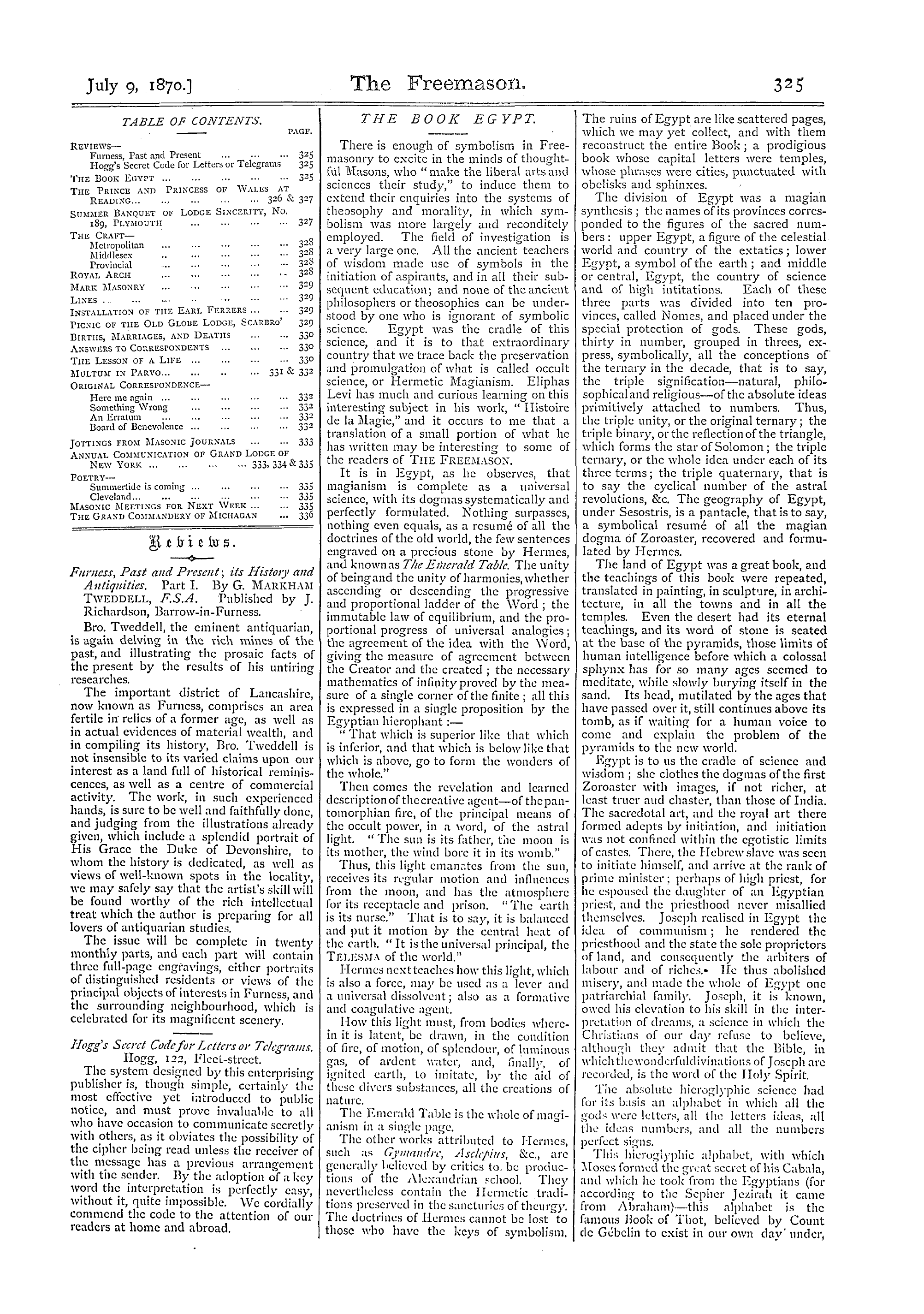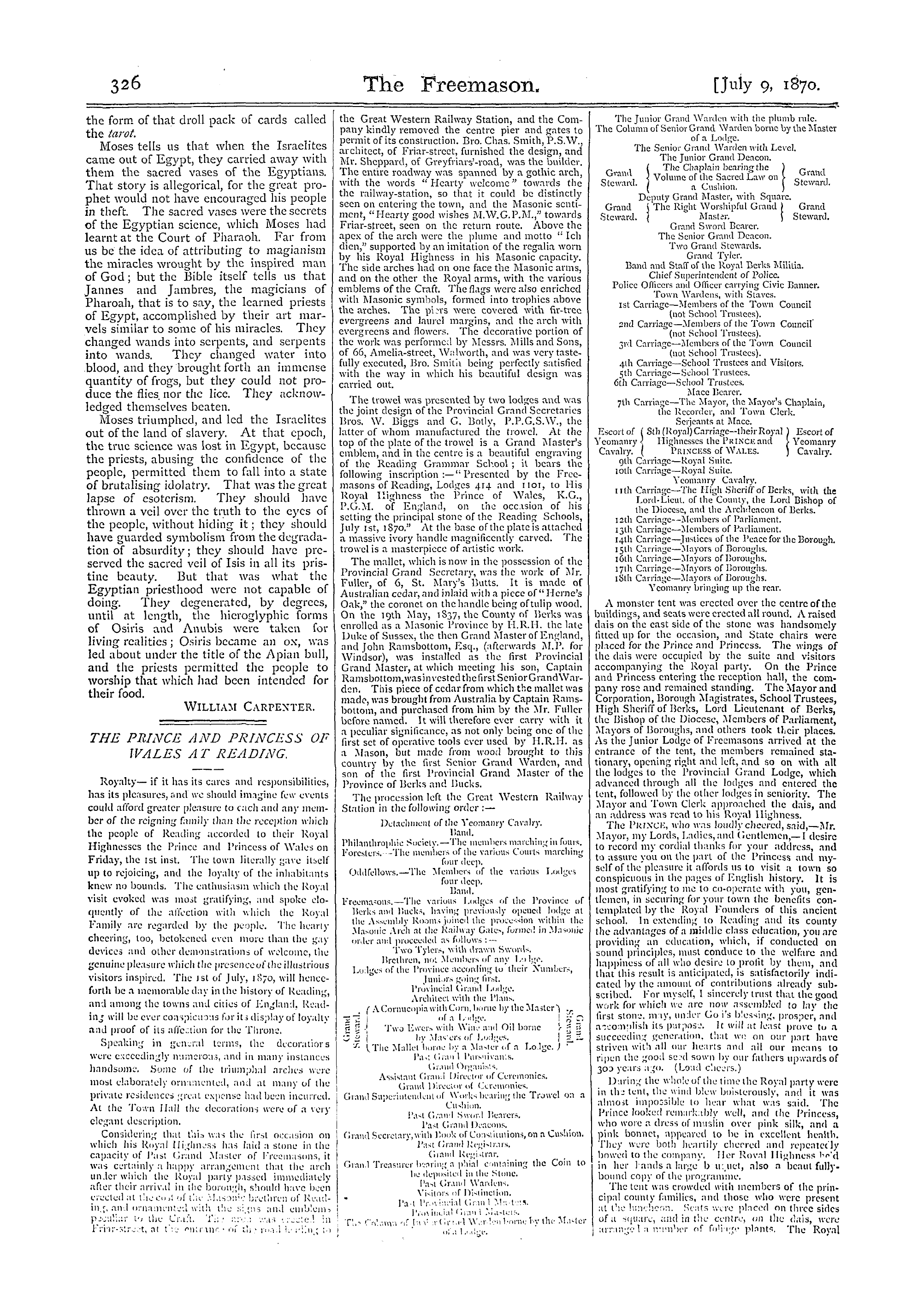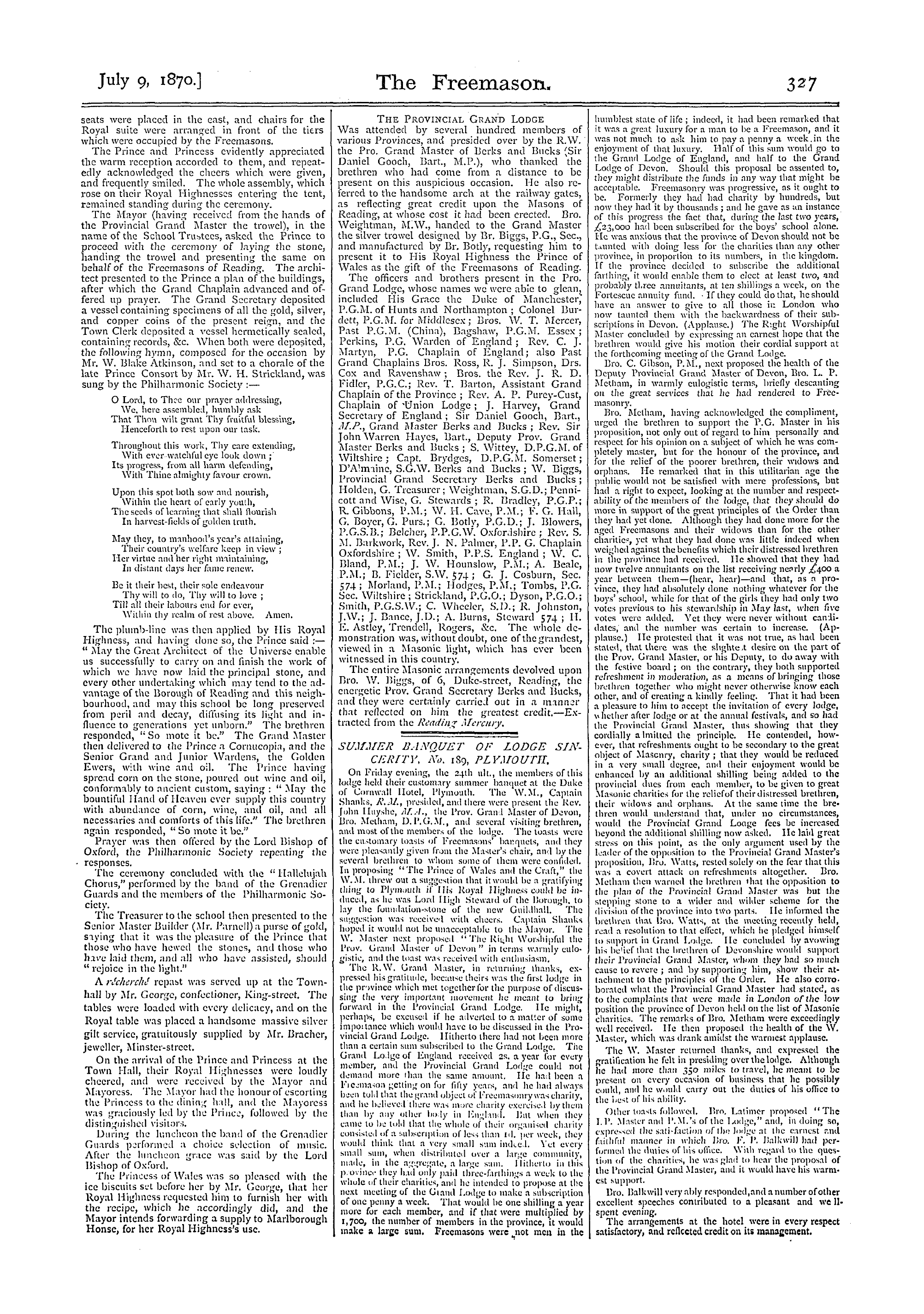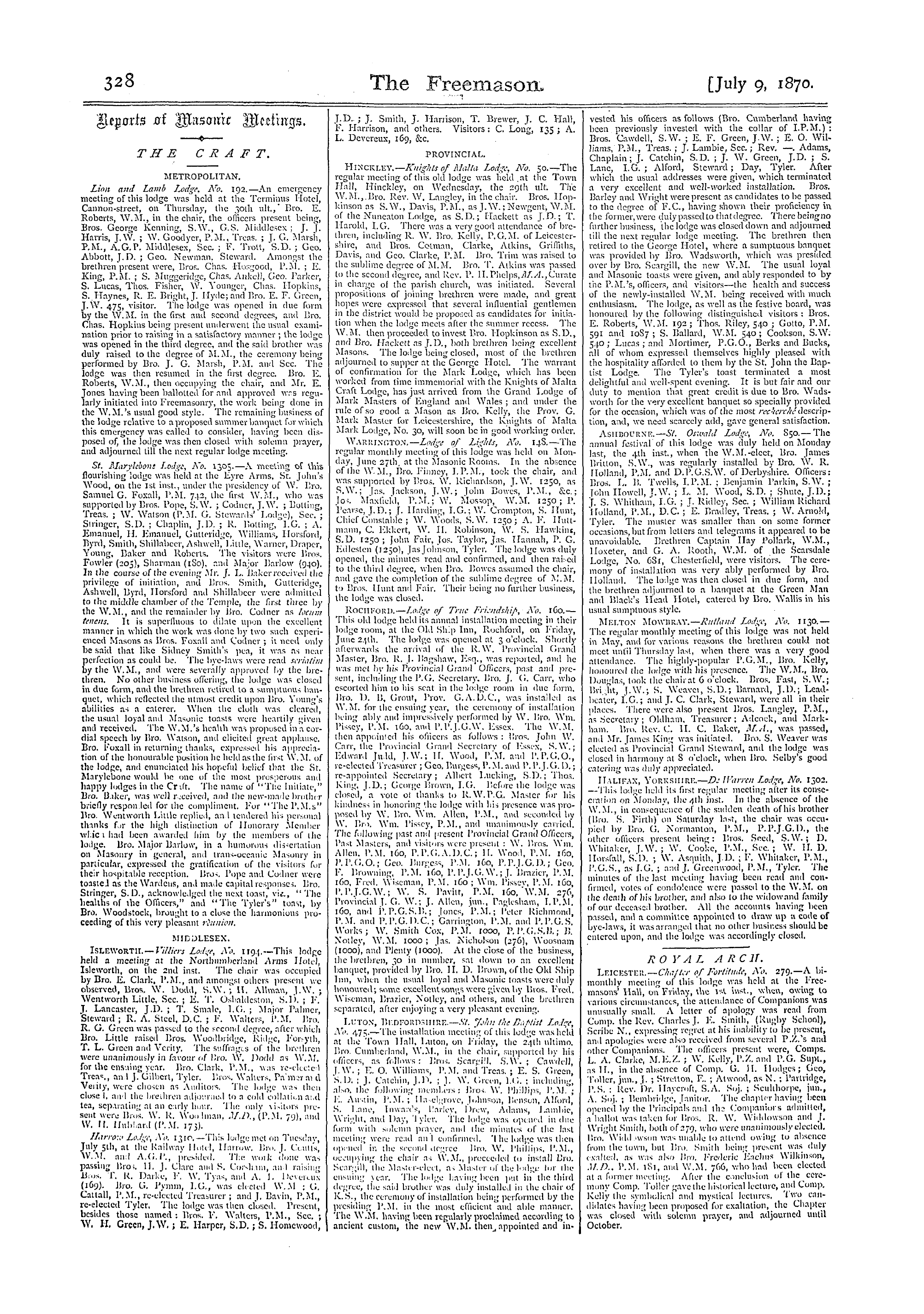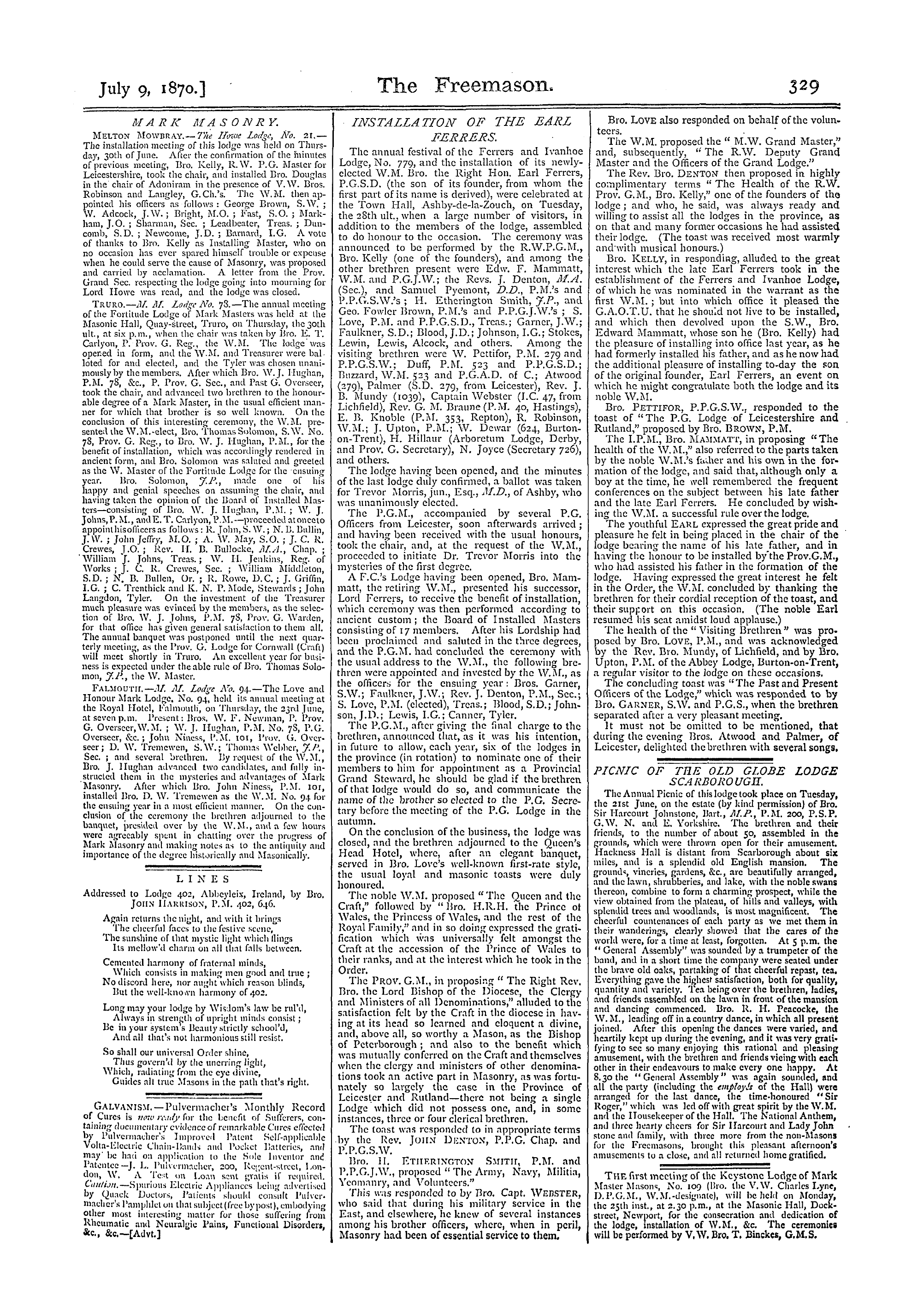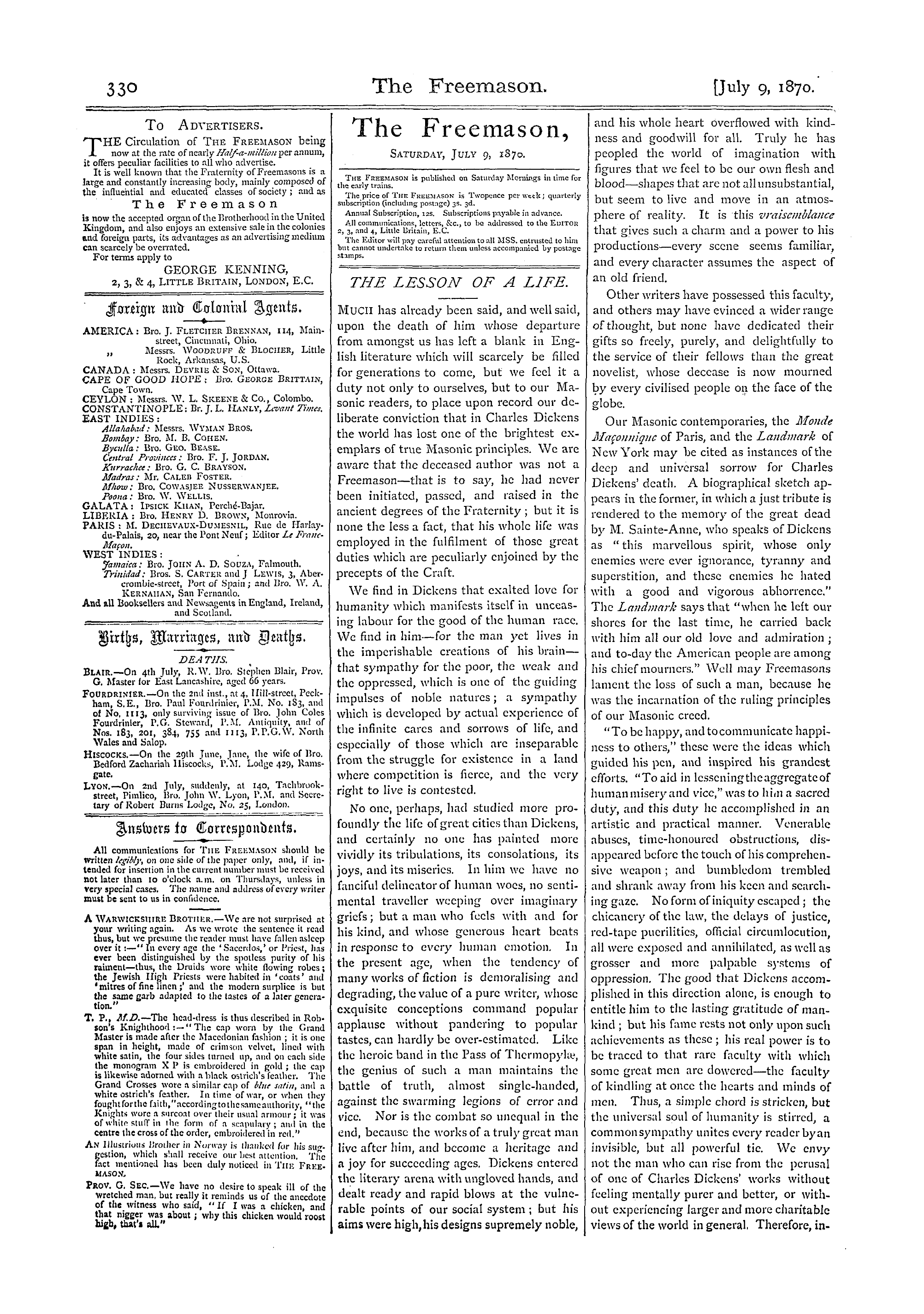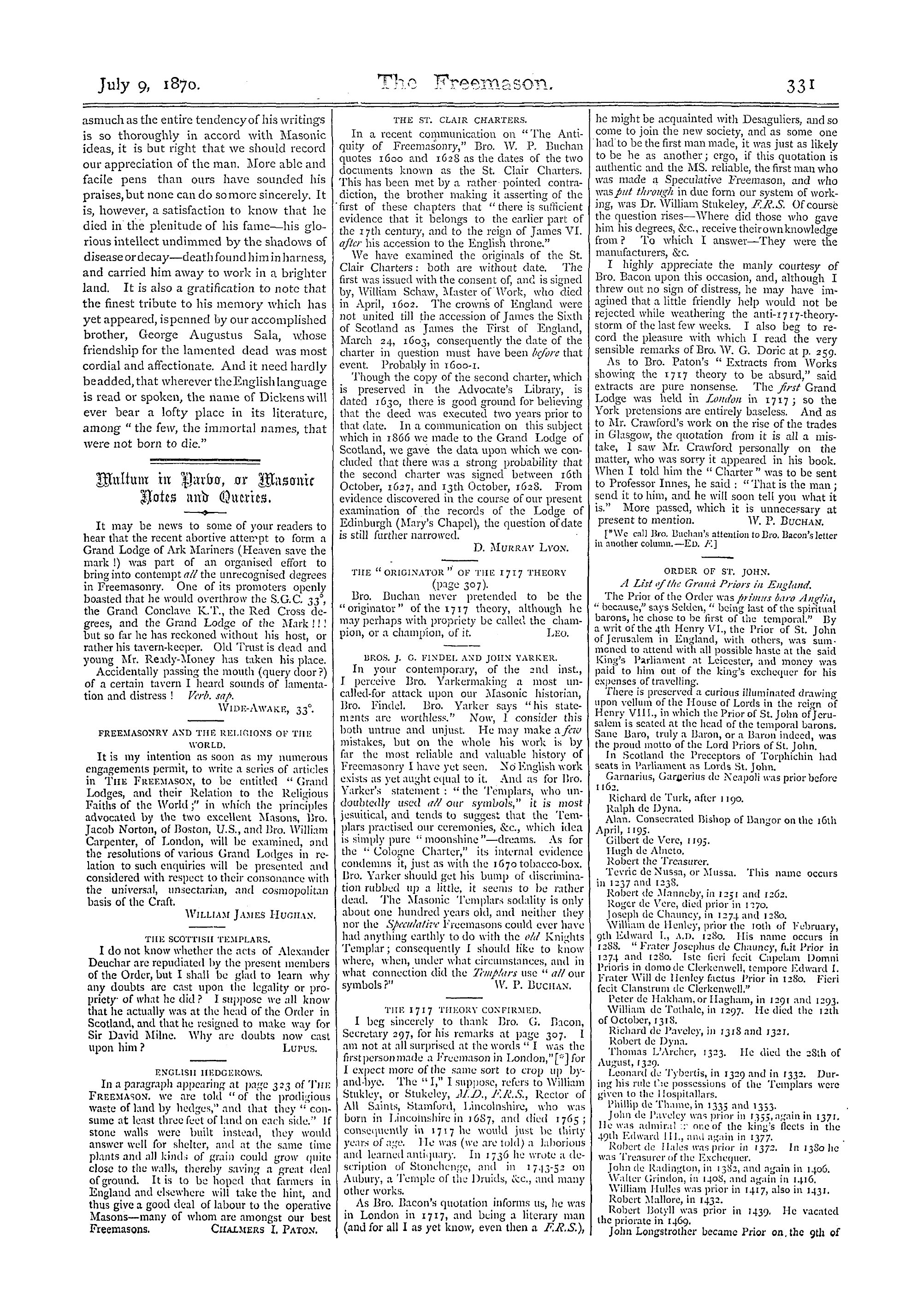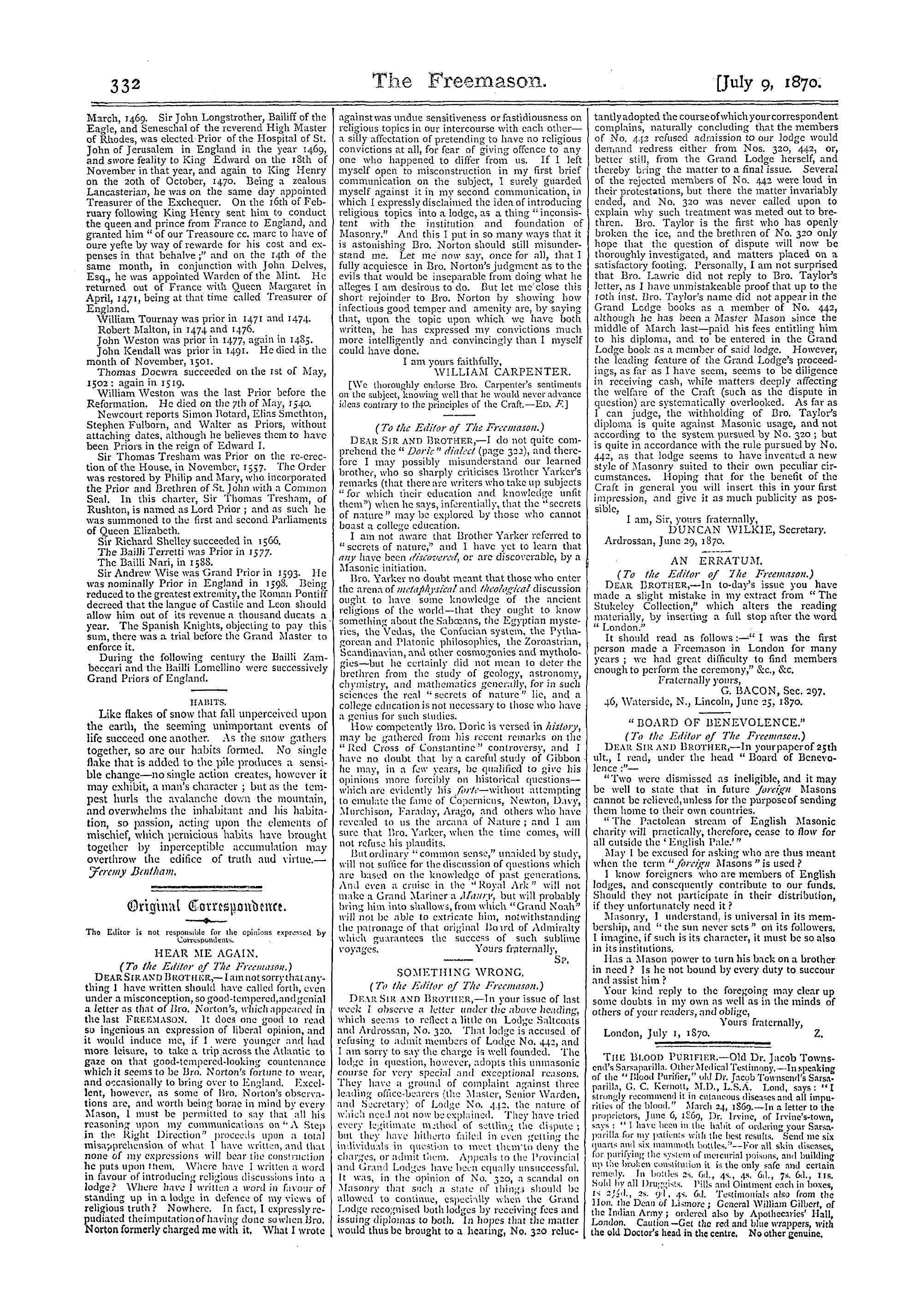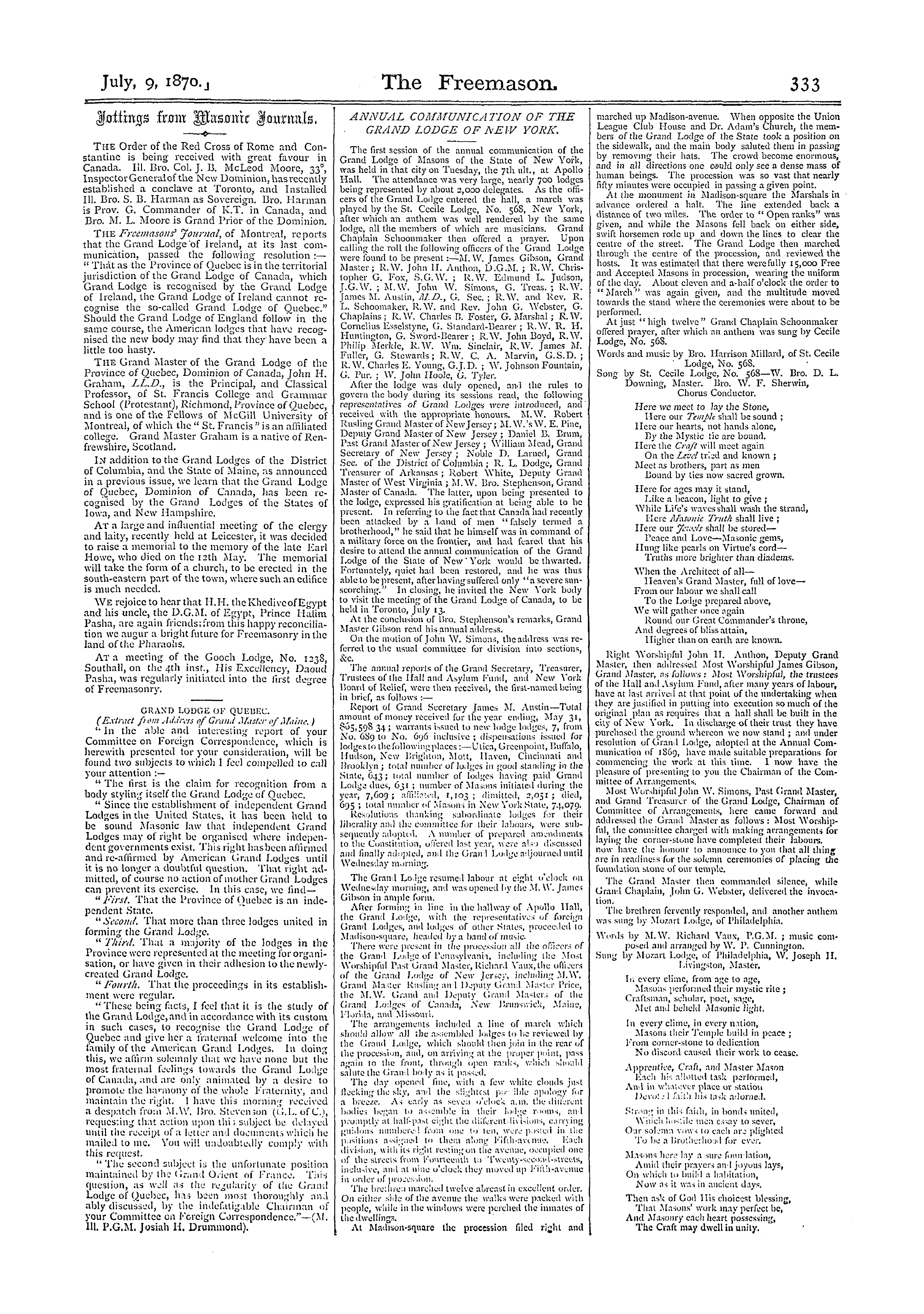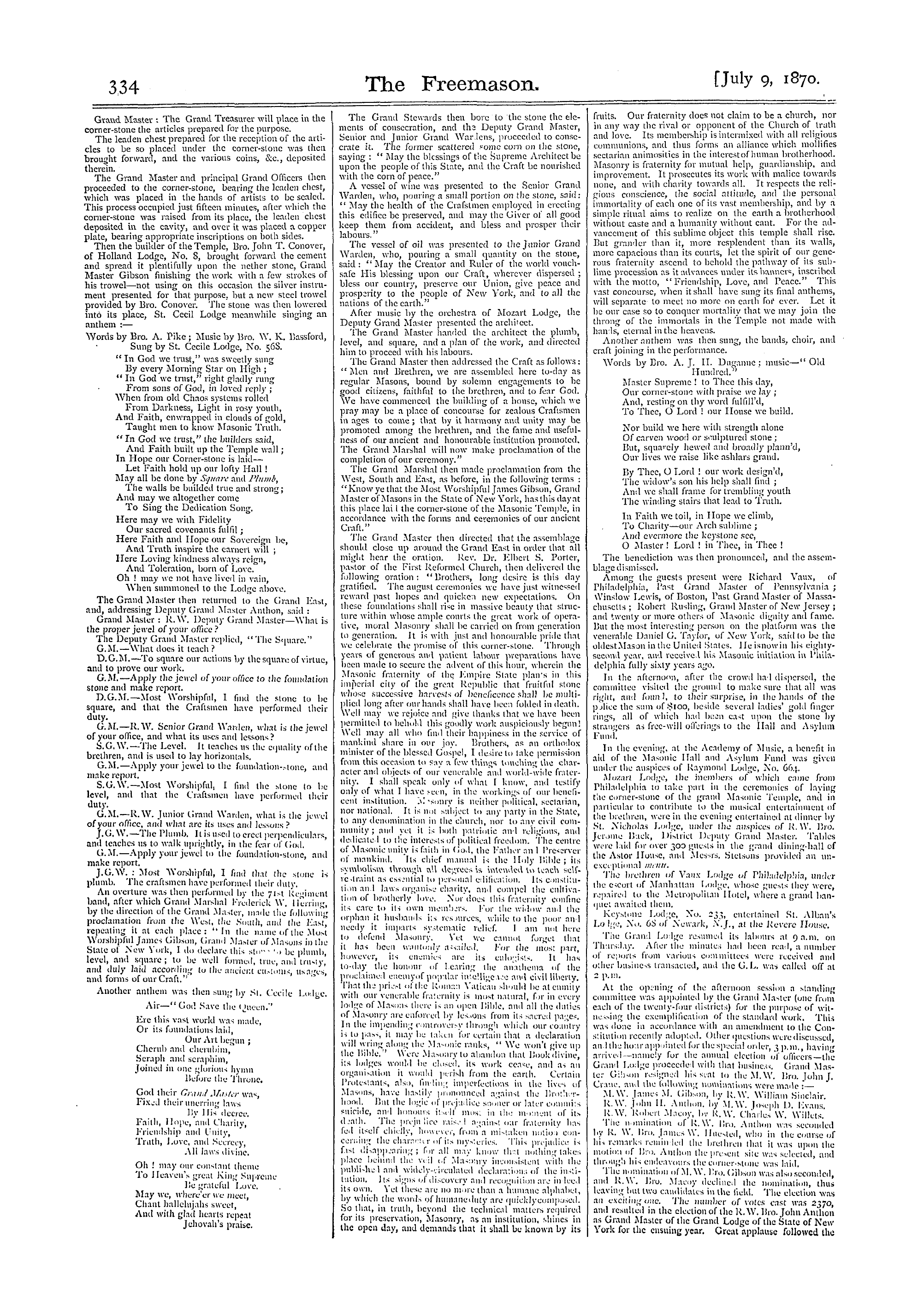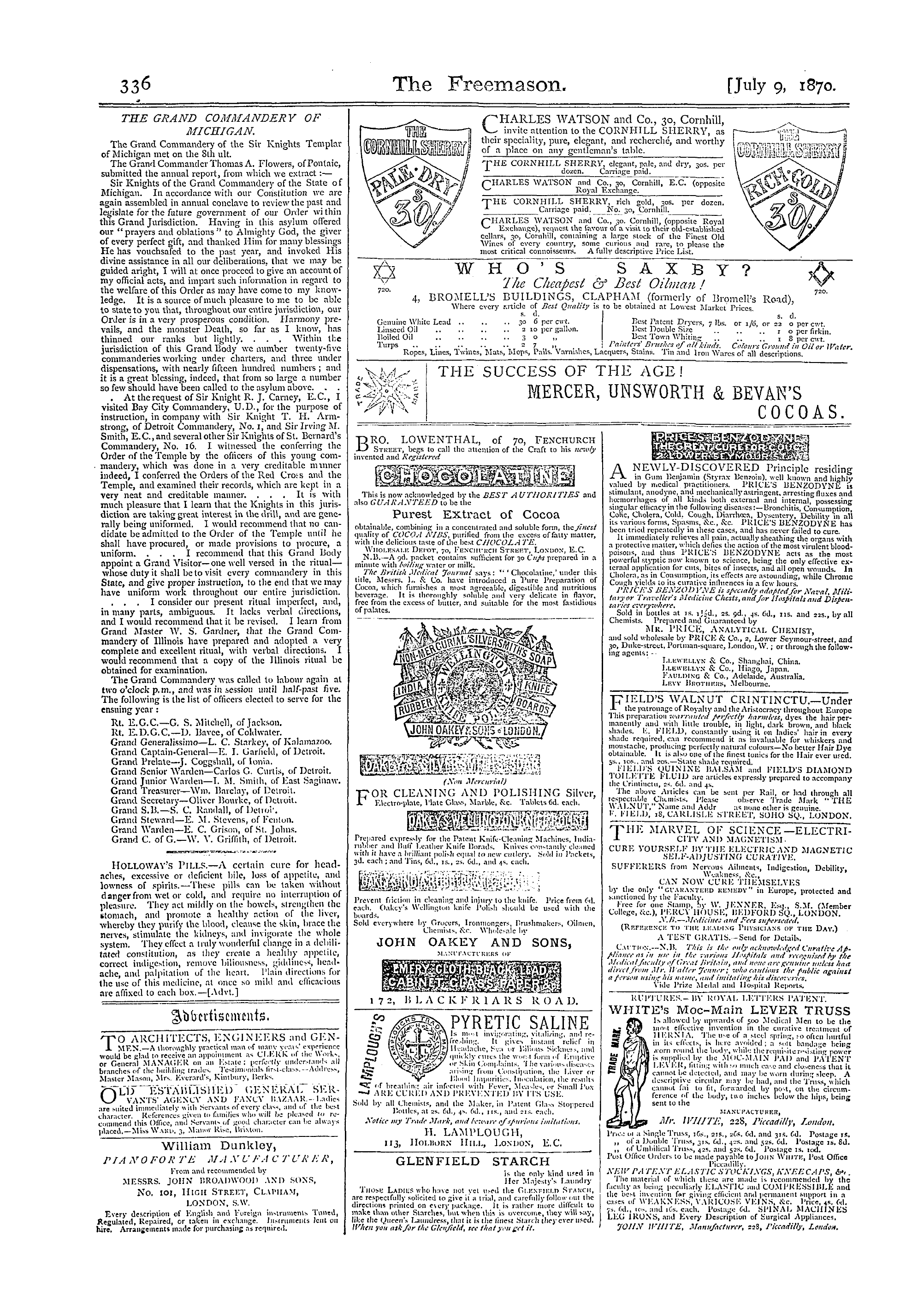-
Articles/Ads
Article THE LESSON OF A LIFE. ← Page 2 of 2 Article Multum in Parbo, or Masonic Notes and Queries. Page 1 of 2 Article Multum in Parbo, or Masonic Notes and Queries. Page 1 of 2 Article Multum in Parbo, or Masonic Notes and Queries. Page 1 of 2 →
Note: This text has been automatically extracted via Optical Character Recognition (OCR) software.
The Lesson Of A Life.
asmuchasthe entire tendency of his writings is so thoroughly in accord with Masonic ideas , it is but right that we should record our appreciation of the man . More able and
facile pens than ours have sounded his praises , but none can do so more sincerely . It is , however , a satisfaction to know that he died in the plenitude of his fame—his
glorious intellect undimmed by the shadows of diseaseor decay—death found him in harness , and carried him away to work in a brighter land . It is also a gratification to note that
the finest tribute to his memory which has yet appeared , ispenned by our accomplished brother , George Augustus Sala , whose friendshi p for the lamented dead was most
cordial and affectionate . And it need hardl y beadded , that wherever theEnglishlanguage is read or spoken , the name of Dickens will
ever bear a lofty place in its literature , among " the few , the immortal names , that were not born to die . "
Multum In Parbo, Or Masonic Notes And Queries.
Multum in Parbo , or Masonic Notes and Queries .
—*—It may be news to some of your readers to hear that the recent abortive attempt to form a Grand Lodge of Ark Mariners ( Heaven save the mark !) was part of an organised effort to
bring into contempt all the unrecognised degrees in Freemasonry . One of its promoters openly boasted that he would overthrow tlie S . G . C . T , f the Grand Conclave K . T ., the Red Cross degrees , and the Grand Lodge of the Mark !! '
but so far he has reckoned without his host , or rather his tavern-keeper . Old Trust is dead and young Mr . Ready-Money lias taken his place .
Accidentally passing the mouth ( query door ?) of a certain tavern I heard sounds of lamentation and distress ! Verb . sap . WIDE-AWAKE , 33 ° .
FREEMASONRY AND THE RELIGIONS OF THE WORLD . It is my intention as soon as my numerous engagements permit , to write a series of articles in THE FREEMASON , to be entitled " Grand
Lodges , and their Relation to the Reli gious Faiths of the World ; " in which the principles advocated by the two excellent Masons , Bro . Jacob Norton , of Boston , U . S ., and Bro . William Carpenter , of London , will be examined , and
the resolutions of various Grand Lodges in relation to such enquiries will be presented and considered with respect to their consonance with the universal , unsectarian , and cosmopolitan basis of the Craft . WILLIAM J AMES HUGHAN .
THE SCOTTISH TEMPLARS . I do not know whether the acts of Alexander Deuchar are repudiated by the present members of tlie Order , but I shall be glad to learn why any doubts arc cast upon the legality or
propriety of what he did ? I suppose we all know that he actually was at tlie head of the Order in Scotland , and that he resigned to make way for Sir David Milne . Why are doubts now cast upon him ? LUPUS .
ENGLISH HEDGEROWS . In a paragraph appearing at page 333 of THE FREEMASON , we are told " of the prodigious waste of land by hedges , " and that they " consume at least three feet of land on eaeli side . " If
stone walls were built instead , they would answer well for shelter , and at the same time plants and all kind . ; of grain could grow quite close to the walls , thereby saving a great deal
of ground . It is to be hoped that farmers in England and elsewhere will take the hint , and thus give a good deal of labour to the operative Masons—many of whom are amongst our best Freemasons . CHALMERS I . PATON .
Multum In Parbo, Or Masonic Notes And Queries.
THE ST . CLAIR CHARTERS . In a recent communication on "The Antiquity of Freemasonry , " Bro . W . P . Buchan quotes 1600 and 1628 as the dates of the two documents known as the St . Clair Charters .
This has been met by a rather pointed contradiction , the brother making it asserting of the first of these chapters that " there is sufficient evidence that it belongs to the earlier part of the 17 th century , and to the reign of James VI .
after his accession to the English throne . We have examined the originals of the St . Clair Charters : botli are without date . The first was issued with the consent of , and is signed by , William Schaw , Master of Work , who died
111 April , 1602 . The crowns of England were not united till the accession of James the Sixth of Scotland as James the First of England , March 24 , 1603 , consequently the date of the charter in question must have been before that event . Probably in 1600-1 .
I hough the copy of the second charter , which is preserved in the Advocate ' s Library , is dated 16 30 , there is good ground for believing that the deed was executed two years prior to that date . In a communication on this subject
which in i 860 we made to the Grand Lodge of Scotland , we gave the data upon which we concluded that there was a strong probability that the second charter was signed between 16 th October , 1627 , and 13 th October , 1628 . From
evidence discovered in the course of our present examination of the records of the Lodge of Edinburgh ( Mary ' s Chapel ) , the question of date is still further narrowed . D . MURRAY LYON .
THE " ORIGINATOR OF THE I 71 7 THEORY ( page 307 ) . Bro . Buchan never pretended to be the " ori ginator" ofthe 1717 theory , although he may perhaps with propriety be called the champion , or a champion , of it . LEO .
BROS . J . G . F 1 NDEL AND JOHN YARKER . In your contemporary , of the 2 nd inst ., I perceive Bro . Yarkermaking a most uncalled-for attack upon our Masonic historian , Bro . Findel . Bro . Yarker says "his
statements are worthless . " Now , I consider this both untrue and unjust . He may make a / cio mistakes , but on the whole his work is by far the most reliable and valuable history of Freemasonry I have yet seen . No English work
exists as yet aught equal to it . And as for Bro . Yarker ' s statement : " the Templars , who undoubtedly used a / l our symbols , " it is most Jesuitical , and tends to suggest that the Templars practised our ceremonies , & c , which idea
is simply pure " moonshine "—dreams . As for the " Cologne Charter , " its internal evidence condemns it , just as with the 1670 tobacco-box . Bro . Yarker should get his bump of discrimination rubbed tip a little , it seems to be rather
dead . The Masonic Templars sodality is only about one hundred years old , and neither they nor the Speculative Freemasons could ever have had anything earthly to do with the old Knights
Templar ; consequently I should like to know where , when , under what circumstances , and in what connection did the Templars use " all om symbols ? " W . P . BUCHAN .
THE 1717 THEORY CONFIRMED . I beg sincerely to thank Bro . G . Bacon , Secretary 297 , for his remarks at page 307 . I am not at all surprised at the words " I was the first person made a Freemason in London , " [''] for
I expect more ot the same sort to crop up byand-byc . The " I , " I suppose , refers to William Stukley , or Stukeley , M . D ., F . R . S ., Rector of All Saints , Stamford , Lincolnshire , who was born in Lincolnshire in 16 S 7 , and diet ! 1765 ;
consequently m 171711 c would just be thirty years of age . He was ( we are told ) a laborious and learned antiquary . In 1736 he wrote a description of Stonehengc , and in 1743-52 on
Anbury , a Temple of the Druids , etc ., and many other works . As Bro . Bacon ' s quotation informs us , lie was in London in 1717 , and being a literary man ( and for all I as yet know , even then a F . R . S . ) ,
Multum In Parbo, Or Masonic Notes And Queries.
he might be acquainted with Desaguliers , and so come to join the new society , and as some one had to be the first man made , it was just as likely to be he as another ; ergo , if this quotation is authentic and the MS . reliable , the first man who was made a Speculative Freemason , and who
wasput through in due form our system of working , was Dr . William Stukeley , F . R . S . Of course the question rises—Where did those who gave him his degrees , & c , receive theirownknowledge from ? To which I answer—They were the manufacturers , & c .
I highly appreciate tlie manly courtesy of Bro . Bacon upon this occasion , and , although I threw out no sign of distress , he may have imagined that a little friendly help would not be rejected while weathering the anti-1717-theorystorm of the last few weeks . I also beg to
record the pleasure with which I read the very sensible remarks of Bro . XV . G . Doric at p . 259 . As to Bro . Paton ' s " Extracts from Works showing the 1717 theory to be absurd , " said extracts are pure nonsense . The first Grand Lodge was held in London in 1717 ; so the
York pretensions are entirel y baseless . And as to Mr . Crawford ' s work on the rise of the trades in Glasgow , tlie quotation from it is all a mistake , 1 saw Mr . Crawford personally on the matter , who was sorry it appeared in his book .
When I told him the " Charter " was to be sent to Professor Innes , he said : " That is the man ; send it to him , and he will soon tell you what it is . " More passed , which it is unnecessary at present to mention . W . P . BUCHAN .
[*\ Vc call Bro . Buchaii ' s attention to Bro . Bacon ' s lettei in another column . —ED . /•' . ]
ORDER OF ST . JOHN . A List ofthe Grand Priors in England . The Prior ofthe Order was primus baro Aiifrlia , " because , " says Selclen , " being last of the spiritual barons , he chose to be first of the temporal . " By a writ ofthe 4 th Henry VI ., the Prior of St . John
of Jerusalem in England , with others , was summoned to attend with all possible haste at the said King ' s Parliament at Leicester , and money was paid to him out of the king ' s exchequer for his expenses of travelling . There is preserved a curious illuminated drawing upon vellum of the House of Lords in the reign of
Henry VIII ., m which the Prior of St . John of Jerusalem is seated at the head of the temporal barons . Sane Baro , truly a Baron , or a Baron indeed , was the proud motto ofthe Lord Priors of St . John . In Scotland the Preceptors of Torphichin had seats in Parliament as Lords St . John . Gainaritts , Garrjeritis de Neapoli was prior before 1162 .
Richard de Turk , after 1190 . Ralph de Dyna . Alan . Consecrated Bishop of Bangor on the 16 th April , 1195 . Gilbert de Verc , 1195 . Hugh de Alncto .
Robert the Treasurer . Tevric de Nussa , or Mussa . This name occurs in 1237 and 1238 . Robert de . Manneby , in 1251 and 1262 . Roger de Verc , died prior in 1170 . Joseph de Chauncv , in 1274 and 1280 .
William de Henley , prior the loth of February , 9 th Edward I ., A . D . 1280 . His name occurs in 128 S . " Prater Joseplius de Cliauncy , ft . it Prior in 1274 and 1280 . Istc fieri fecit Capelam Uomni Prions in domode Clerkenwell , tempore Edward I . Fratcr Will de Henley factus Prior in 1280 . Fieri fecit Clanstruni de Clerkenwell . "
Peter de Hakham , or Ilaghani , in 1291 and 1293 . William de Tothalc , in 1297 . He died the 12 th of October , 131 S . Richard de Pavelcy , in ijiSand 1321 . Robert de Dyna . Thomas L'Arehcr , 1323 . He died the 28 th of
August , 1329 . Leonard de Tybertis , in 1329 and in 1332 . During his rule tbc possessions of the Templars were given to the Ilospitallars . Phillip de Thame , in 1335 and 1353 . John de Pavelcy was prior in 13 ;; , again in \ yi \
lie was admiral :: ' one of the king ' s fleets in the 49 th Edward III ., ami again in 1377 . Robert de Hales was prior in 1372 . In l 3 Solie was Treasurer of the Exchequer . John do Radington , in 1382 , and again in 1406 .
Walter Grindon , in 1408 , and again in 14 . 16 . William Hulles was prior in 1417 , also in 1431 . Robert . Mallore , in 1432 . Robert Botyll was prior in 1439 . He vacated the prioratc in 1 469 . John Longstrother became Prior on , the 9 th of
Note: This text has been automatically extracted via Optical Character Recognition (OCR) software.
The Lesson Of A Life.
asmuchasthe entire tendency of his writings is so thoroughly in accord with Masonic ideas , it is but right that we should record our appreciation of the man . More able and
facile pens than ours have sounded his praises , but none can do so more sincerely . It is , however , a satisfaction to know that he died in the plenitude of his fame—his
glorious intellect undimmed by the shadows of diseaseor decay—death found him in harness , and carried him away to work in a brighter land . It is also a gratification to note that
the finest tribute to his memory which has yet appeared , ispenned by our accomplished brother , George Augustus Sala , whose friendshi p for the lamented dead was most
cordial and affectionate . And it need hardl y beadded , that wherever theEnglishlanguage is read or spoken , the name of Dickens will
ever bear a lofty place in its literature , among " the few , the immortal names , that were not born to die . "
Multum In Parbo, Or Masonic Notes And Queries.
Multum in Parbo , or Masonic Notes and Queries .
—*—It may be news to some of your readers to hear that the recent abortive attempt to form a Grand Lodge of Ark Mariners ( Heaven save the mark !) was part of an organised effort to
bring into contempt all the unrecognised degrees in Freemasonry . One of its promoters openly boasted that he would overthrow tlie S . G . C . T , f the Grand Conclave K . T ., the Red Cross degrees , and the Grand Lodge of the Mark !! '
but so far he has reckoned without his host , or rather his tavern-keeper . Old Trust is dead and young Mr . Ready-Money lias taken his place .
Accidentally passing the mouth ( query door ?) of a certain tavern I heard sounds of lamentation and distress ! Verb . sap . WIDE-AWAKE , 33 ° .
FREEMASONRY AND THE RELIGIONS OF THE WORLD . It is my intention as soon as my numerous engagements permit , to write a series of articles in THE FREEMASON , to be entitled " Grand
Lodges , and their Relation to the Reli gious Faiths of the World ; " in which the principles advocated by the two excellent Masons , Bro . Jacob Norton , of Boston , U . S ., and Bro . William Carpenter , of London , will be examined , and
the resolutions of various Grand Lodges in relation to such enquiries will be presented and considered with respect to their consonance with the universal , unsectarian , and cosmopolitan basis of the Craft . WILLIAM J AMES HUGHAN .
THE SCOTTISH TEMPLARS . I do not know whether the acts of Alexander Deuchar are repudiated by the present members of tlie Order , but I shall be glad to learn why any doubts arc cast upon the legality or
propriety of what he did ? I suppose we all know that he actually was at tlie head of the Order in Scotland , and that he resigned to make way for Sir David Milne . Why are doubts now cast upon him ? LUPUS .
ENGLISH HEDGEROWS . In a paragraph appearing at page 333 of THE FREEMASON , we are told " of the prodigious waste of land by hedges , " and that they " consume at least three feet of land on eaeli side . " If
stone walls were built instead , they would answer well for shelter , and at the same time plants and all kind . ; of grain could grow quite close to the walls , thereby saving a great deal
of ground . It is to be hoped that farmers in England and elsewhere will take the hint , and thus give a good deal of labour to the operative Masons—many of whom are amongst our best Freemasons . CHALMERS I . PATON .
Multum In Parbo, Or Masonic Notes And Queries.
THE ST . CLAIR CHARTERS . In a recent communication on "The Antiquity of Freemasonry , " Bro . W . P . Buchan quotes 1600 and 1628 as the dates of the two documents known as the St . Clair Charters .
This has been met by a rather pointed contradiction , the brother making it asserting of the first of these chapters that " there is sufficient evidence that it belongs to the earlier part of the 17 th century , and to the reign of James VI .
after his accession to the English throne . We have examined the originals of the St . Clair Charters : botli are without date . The first was issued with the consent of , and is signed by , William Schaw , Master of Work , who died
111 April , 1602 . The crowns of England were not united till the accession of James the Sixth of Scotland as James the First of England , March 24 , 1603 , consequently the date of the charter in question must have been before that event . Probably in 1600-1 .
I hough the copy of the second charter , which is preserved in the Advocate ' s Library , is dated 16 30 , there is good ground for believing that the deed was executed two years prior to that date . In a communication on this subject
which in i 860 we made to the Grand Lodge of Scotland , we gave the data upon which we concluded that there was a strong probability that the second charter was signed between 16 th October , 1627 , and 13 th October , 1628 . From
evidence discovered in the course of our present examination of the records of the Lodge of Edinburgh ( Mary ' s Chapel ) , the question of date is still further narrowed . D . MURRAY LYON .
THE " ORIGINATOR OF THE I 71 7 THEORY ( page 307 ) . Bro . Buchan never pretended to be the " ori ginator" ofthe 1717 theory , although he may perhaps with propriety be called the champion , or a champion , of it . LEO .
BROS . J . G . F 1 NDEL AND JOHN YARKER . In your contemporary , of the 2 nd inst ., I perceive Bro . Yarkermaking a most uncalled-for attack upon our Masonic historian , Bro . Findel . Bro . Yarker says "his
statements are worthless . " Now , I consider this both untrue and unjust . He may make a / cio mistakes , but on the whole his work is by far the most reliable and valuable history of Freemasonry I have yet seen . No English work
exists as yet aught equal to it . And as for Bro . Yarker ' s statement : " the Templars , who undoubtedly used a / l our symbols , " it is most Jesuitical , and tends to suggest that the Templars practised our ceremonies , & c , which idea
is simply pure " moonshine "—dreams . As for the " Cologne Charter , " its internal evidence condemns it , just as with the 1670 tobacco-box . Bro . Yarker should get his bump of discrimination rubbed tip a little , it seems to be rather
dead . The Masonic Templars sodality is only about one hundred years old , and neither they nor the Speculative Freemasons could ever have had anything earthly to do with the old Knights
Templar ; consequently I should like to know where , when , under what circumstances , and in what connection did the Templars use " all om symbols ? " W . P . BUCHAN .
THE 1717 THEORY CONFIRMED . I beg sincerely to thank Bro . G . Bacon , Secretary 297 , for his remarks at page 307 . I am not at all surprised at the words " I was the first person made a Freemason in London , " [''] for
I expect more ot the same sort to crop up byand-byc . The " I , " I suppose , refers to William Stukley , or Stukeley , M . D ., F . R . S ., Rector of All Saints , Stamford , Lincolnshire , who was born in Lincolnshire in 16 S 7 , and diet ! 1765 ;
consequently m 171711 c would just be thirty years of age . He was ( we are told ) a laborious and learned antiquary . In 1736 he wrote a description of Stonehengc , and in 1743-52 on
Anbury , a Temple of the Druids , etc ., and many other works . As Bro . Bacon ' s quotation informs us , lie was in London in 1717 , and being a literary man ( and for all I as yet know , even then a F . R . S . ) ,
Multum In Parbo, Or Masonic Notes And Queries.
he might be acquainted with Desaguliers , and so come to join the new society , and as some one had to be the first man made , it was just as likely to be he as another ; ergo , if this quotation is authentic and the MS . reliable , the first man who was made a Speculative Freemason , and who
wasput through in due form our system of working , was Dr . William Stukeley , F . R . S . Of course the question rises—Where did those who gave him his degrees , & c , receive theirownknowledge from ? To which I answer—They were the manufacturers , & c .
I highly appreciate tlie manly courtesy of Bro . Bacon upon this occasion , and , although I threw out no sign of distress , he may have imagined that a little friendly help would not be rejected while weathering the anti-1717-theorystorm of the last few weeks . I also beg to
record the pleasure with which I read the very sensible remarks of Bro . XV . G . Doric at p . 259 . As to Bro . Paton ' s " Extracts from Works showing the 1717 theory to be absurd , " said extracts are pure nonsense . The first Grand Lodge was held in London in 1717 ; so the
York pretensions are entirel y baseless . And as to Mr . Crawford ' s work on the rise of the trades in Glasgow , tlie quotation from it is all a mistake , 1 saw Mr . Crawford personally on the matter , who was sorry it appeared in his book .
When I told him the " Charter " was to be sent to Professor Innes , he said : " That is the man ; send it to him , and he will soon tell you what it is . " More passed , which it is unnecessary at present to mention . W . P . BUCHAN .
[*\ Vc call Bro . Buchaii ' s attention to Bro . Bacon ' s lettei in another column . —ED . /•' . ]
ORDER OF ST . JOHN . A List ofthe Grand Priors in England . The Prior ofthe Order was primus baro Aiifrlia , " because , " says Selclen , " being last of the spiritual barons , he chose to be first of the temporal . " By a writ ofthe 4 th Henry VI ., the Prior of St . John
of Jerusalem in England , with others , was summoned to attend with all possible haste at the said King ' s Parliament at Leicester , and money was paid to him out of the king ' s exchequer for his expenses of travelling . There is preserved a curious illuminated drawing upon vellum of the House of Lords in the reign of
Henry VIII ., m which the Prior of St . John of Jerusalem is seated at the head of the temporal barons . Sane Baro , truly a Baron , or a Baron indeed , was the proud motto ofthe Lord Priors of St . John . In Scotland the Preceptors of Torphichin had seats in Parliament as Lords St . John . Gainaritts , Garrjeritis de Neapoli was prior before 1162 .
Richard de Turk , after 1190 . Ralph de Dyna . Alan . Consecrated Bishop of Bangor on the 16 th April , 1195 . Gilbert de Verc , 1195 . Hugh de Alncto .
Robert the Treasurer . Tevric de Nussa , or Mussa . This name occurs in 1237 and 1238 . Robert de . Manneby , in 1251 and 1262 . Roger de Verc , died prior in 1170 . Joseph de Chauncv , in 1274 and 1280 .
William de Henley , prior the loth of February , 9 th Edward I ., A . D . 1280 . His name occurs in 128 S . " Prater Joseplius de Cliauncy , ft . it Prior in 1274 and 1280 . Istc fieri fecit Capelam Uomni Prions in domode Clerkenwell , tempore Edward I . Fratcr Will de Henley factus Prior in 1280 . Fieri fecit Clanstruni de Clerkenwell . "
Peter de Hakham , or Ilaghani , in 1291 and 1293 . William de Tothalc , in 1297 . He died the 12 th of October , 131 S . Richard de Pavelcy , in ijiSand 1321 . Robert de Dyna . Thomas L'Arehcr , 1323 . He died the 28 th of
August , 1329 . Leonard de Tybertis , in 1329 and in 1332 . During his rule tbc possessions of the Templars were given to the Ilospitallars . Phillip de Thame , in 1335 and 1353 . John de Pavelcy was prior in 13 ;; , again in \ yi \
lie was admiral :: ' one of the king ' s fleets in the 49 th Edward III ., ami again in 1377 . Robert de Hales was prior in 1372 . In l 3 Solie was Treasurer of the Exchequer . John do Radington , in 1382 , and again in 1406 .
Walter Grindon , in 1408 , and again in 14 . 16 . William Hulles was prior in 1417 , also in 1431 . Robert . Mallore , in 1432 . Robert Botyll was prior in 1439 . He vacated the prioratc in 1 469 . John Longstrother became Prior on , the 9 th of
